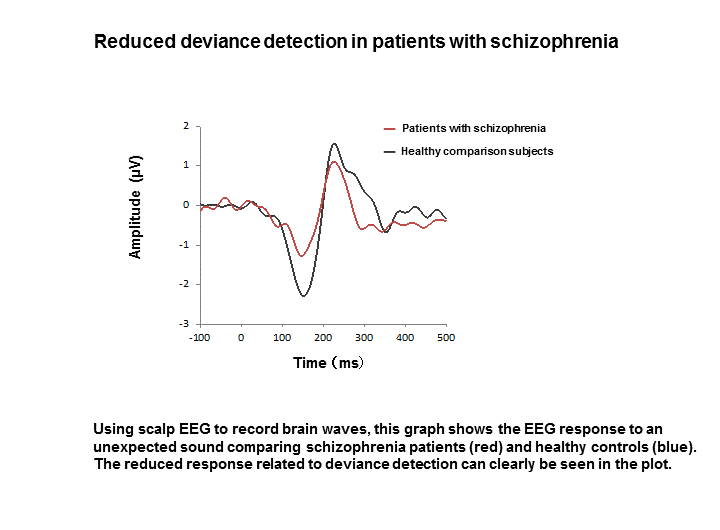
Schizophrenia is a common mental illness characterized by disordered sensing and thinking. Symptoms include recurrent episodes of psychosis, including hallucinations and delusions, and can extend to affective and motivational deficits. Despite more than a half century of research, schizophrenia remains one of the most poorly understood and clinically intractable mental conditions. Animal models are generally inaccurate and clinical studies are limited.
One of the promising leads in clinical investigation is the relatively recent identification of a measurable candidate biomarker in the brains of patients. This biomarker, called auditory mismatch negativity (MMN), is elicited in the laboratory by a series of auditory tones, some of which are rhythmically predictable and others that are random and therefore unpredictable. Scalp electroencephalography (EEG) can be used to measure electrical responses for MMN.
It turns out that the brains of patients with schizophrenia have a reduced MMN response when compared to healthy subjects, suggesting altered processing of sensory stimulation, which is in turn hypothesized as defective building blocks that might contribute to larger defects in brain signaling. The problem is that the MMN biomarker remains only a clinical observation – it is not “explainable” - because its biological basis is completely unknown.
In a new study recently published in the journal Schizophrenia Bulletin, a team of clinical researchers at The University of Tokyo Graduate School of Medicine and the International Research Center for Neurointelligence led by Kiyoto Kasai investigated the MMN biomarker in a cohort of schizophrenia patients to better understand it unique brain signatures. They used a new type of auditory stimulus designed to disentangle the EEG signals of the MMN.
The results showed that brains of patients with schizophrenia responds to auditory mismatch negativity due to a defect in a property called “deviance detection”, the ability to respond to unexpected tones accurately. In contrast, other MMN properties such as adaptation and tone differences were unaltered. The results provide definitive support for the “deviance detection hypothesis” one of several competing explanations for the MMN in the schizophrenic brain.
While this result is not entirely unexpected, it will greatly help in narrowing the search for understanding what defects contribute to schizophrenia. In some animal models, the MMN is associated with a specific molecular target called the NMDA receptor. Future research in both patients and animals will try to use these clues to identify neuronal circuits and cells for the MMN response and facilitate the future development of better diagnostics and therapies.
Correspondent: Charles Yokoyama, Ph.D., IRCN Science Writing Core
Reference: Koshiyama, D., Kirihara, K., Tada, M., Nagai, T., Fujioka, M., Usui, K., Araki, T., Kasai, K. (2020) Reduced Auditory Mismatch Negativity Reflects Impaired Deviance Detection in Schizophrenia. Schizophrenia Bulletin, DOI: 10.1093/schbul/sbaa006
Media Contact: The author is available for interviews in English.
Professor Kiyoto Kasai, Ph.D.
School of Medicine
International Research Center for Neurointelligence (IRCN)
The University of Tokyo Institutes for Advanced Study
Mayuki Satake
Public Relations
International Research Center for Neurointelligence (IRCN)
The University of Tokyo Institutes for Advanced Study
press@ircn.jp


